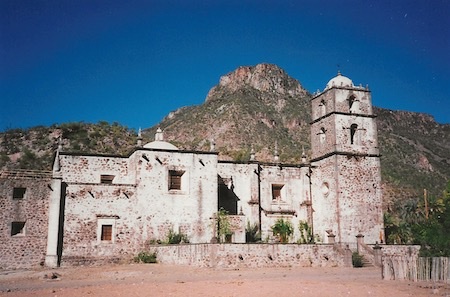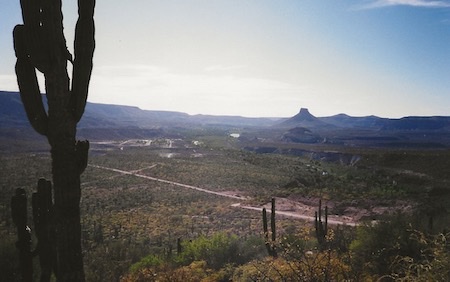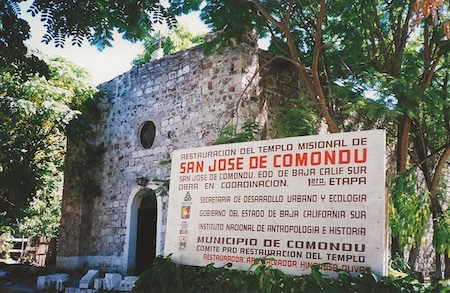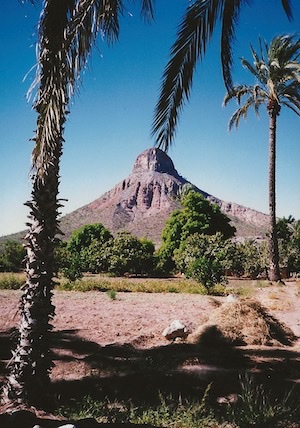 |  |
By Greg Niemann

Take a time machine back 100 years or more. For the real thing, take a day-long driving loop into the rugged Baja mountains out of Loreto. (My buddy Don Lund and I did this particular excursion back in 1994).
The graded dirt road, suitable for most high clearance vehicles, leaves Highway #1 just 1.1 miles south of Loreto. The entire mountain loop passes several historic missions, fertile, self-sustaining valleys and sleepy villages. It goes over country so high we could see both the Pacific Ocean and the Sea of Cortez at the same time. The loop ends back on Highway #1, only 37 miles north of Loreto.
Don and I had been successfully fishing the Loreto waters and headed off to explore more of the interior. It was a 23-mile dirt road from Highway #1 to Mission San Javier (or Xavier). First the road winded through about six miles of low hills, then ascended rapidly up into the Sierra de la Giganta.
The stream bed of a picturesque palm canyon displayed remnants of the original old road which can still be seen hugging the steep canyon wall. About halfway to San Javier is an oasis called Las Parras, with a stone chapel, groves of olive and citrus trees and several dogs barking over their domain.
Mission San Javier
From a high barren hill we dropped down into a fertile, narrow valley. Arriving in San Javier, we passed a few inviting natural blue-green pools that provide sustenance for livestock and the hardy ranching families who occupy this serene and secluded mountain village.
(Today, 2022, the road from Loreto to San Javier is paved and in good condition. It is a regular day trip for tour companies.)

While I’d seen many photos of the Mission San Javier, its majestic presence still overwhelmed us as we rolled into town. Past small ranchos and a school, the dirt road ended at a long, wide plaza, almost like a boulevard, complete with concrete planters and curbs, leading directly to the stately mission.
San Javier is considered one of the most beautiful and best preserved of all of Baja’s missions. It alone is a delightful and rewarding experience.
After Loreto was established in 1697, Indigenous People from these rugged mountains came down to visit the new settlement. Padre Francisco Piccolo followed them back to a place with friendly people, a stream and land to graze cattle.
With much difficulty he built a road and little chapel, dedicating the mission on Nov. 1, 1699. During a drought in 1720 he was forced to move to a farm about seven miles south.
There Padre Juan de Ugarte replaced Piccolo and built the current Mission San Francisco Xavier de Vigge. Costing over $1 million pesos, it boasts a stone belfry and Moorish spires. The intricate and detailed stonework is still outstanding. It was completed in 1758, over 260 years ago.
Black lava cliffs surround the quiet valley, providing a reverential stillness and stark contrast to the white domes of the mission. The chapel is open, maintained regularly, and features paintings, vestments, and artifacts from earlier centuries.
Don and I entered and saw an old woman busy cleaning. The devout old caretaker answered our questions while continuing to work, dusting centuries-old statues and gilt-edged oil paintings with reverence and familiarity. We left a few pesos in donation.
Time stands still here, for this woman, and for all in this valley. Stateside California missions have gift shops and fax machines and computers to order and log supplies. Not here. Material possessions and modern devices are not only absent but are totally meaningless amid the simple life of this small Baja village. Love of family and a strong faith are the riches coveted and respected by these most unpretentious people.
From San Javier, we had to backtrack four miles to a junction and then head north 26 miles to the Comondus. The road passes a couple of small ranchos and a few goat herds and offers some spectacular views.
Two villages called Comondu

The Comondus are actually two villages, San Jose de Comondu and San Miguel de Comondu, about two miles apart. After the rough, barren, rocky high country, the lush valley is a welcome sight. San Jose de Comondu is reached first, with date palms and tropical foliage creating a “green carpet” welcome into town.
The original Comondu mission was established about 24 miles north of this site in 1708. It was moved to this village of San Jose in 1737. One stone building of the mission still stands next to the plaza and the original bells hang nearby. There is a small store across from the plaza.
The valley floor covers seven miles of lush vegetation, and two miles down valley is San Miguel de Comondu. It appears to be a larger village, but many of the buildings are no longer in use. Several workers can be seen climbing palms to harvest dates, and families nearby quietly and gently sort and dry them in the warm Baja sun.
Upon inquiry, visitors are led to a home where meals are prepared. No menu, but the food is good and reasonable. Youngsters practice their English on travelers by yelling their halting “How are you’s” and “What is your name?” from a schoolyard across the street from a chapel built as recently as 1905. Previously, a visita mission dating from 1714 was established there.
From the Comondus, one can head northeast to El Crucero and a shorter, although little tougher, road to Highway #1, or continue northwest to the villages of San Isidro and La Purisima.
Aqueduct graces San Isidro
We wanted to see San Isidro and La Purisima and left the Comondus on a winding rocky road. The oasis village of San Isidro, 16 miles north of San Jose de Comondu, lies in another remote and deep valley surrounded by high cliffs and rugged desert. Most interesting is an aqueduct built out of stone that runs alongside the road further irrigating the verdant valley. San Isidro, with a population of 600, has a few stores and a small cafe.
La Purisima - Most populous mission
Three miles down valley is the town of La Purisima, which greets a paved road from Ciudad Insurgentes in the south. La Purisima has such a feeling of remoteness and laid-back charm we felt cheated upon seeing the pavement.

La Purisima was established by Padre Nicolas Tamaral who, after first visiting in 1712, returned in 1717 to establish a mission. He and Indigenous People built roads through the sierras from Mulege on the gulf to the Comondus and La Purisima. Soon, there were over 2,000 Indigenous People and grain and orchards were planted to feed them.
While Padre Tamaral ruled the Indigenous People with an iron fist, the mission was considered one of the most successful. In a 1730 report, it was considered by the padres the most populous and best cared for in the peninsula. Wonder what the Indigenous People thought?
The Indigenous population was decimated by disease and the mission was abandoned in 1822. Only a few mounds of adobe from the original mission remain. The charming valley, overlooked by a dramatic butte called El Pilon, is fertile due to the elaborate irrigation system. Grown there are dates, mangoes, citrus fruits, corn, grapes, tomatoes, chilies and beans. About 700 people live in La Purisima and limited supplies are available.
It’s about 30 miles back along good, high clearance dirt road to Highway #1, only 10 miles south of the southern tip of Bahia Concepcion. Don and I were hot, dusty and tired when we rejoined the highway. We sped up the smooth asphalt road, heading directly for a sand-spit called El Requeson and a refreshing dip in the bay.
“The pavement feels good,” said Don as we got into higher gears on the highway, “Do you think they’ll ever pave those mountain roads?”
I glanced back up at the steep, rocky eastern escarpment of the Sierra de la Giganta. I thought about the timelessness of the remote villages and valleys. I thought about the warm, friendly people that prevail in the remote backcountry of Baja.
“I sure hope not,” I said. “I sure hope not.”
About Greg
Greg Niemann, a long-time Baja writer, is the author of Baja Fever, Baja Legends, Palm Springs Legends, Las Vegas Legends, and Big Brown: The Untold Story of UPS. Visit www.gregniemann.com.